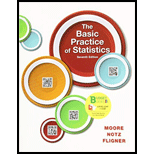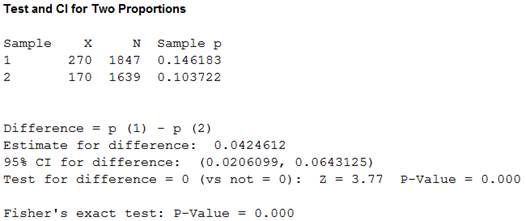
(a)
To find: The sample proportions of Medicare patients who experienced overall complications from bariatric surgery before and after the CMS restriction on coverage.
To test: Whether there is evidence that the proportions of overall complications are different before and after the CMS restriction or not.
(a)
Answer to Problem 23.24E
The sample proportions of Medicare patients who experienced overall complications from bariatric surgery before the CMS restriction on coverage is 0.146.
The sample proportions of Medicare patients who experienced overall complications from bariatric surgery after the CMS restriction on coverage is 0.104.
The conclusion is that, there is evidence that the proportions of overall complications are different before and after the CMS restriction.
Explanation of Solution
Given info:
In the survey, out of 1,847 Medicare patient 270 patients experienced overall complications and out of 1,639 Medicare patients having bariatric surgery 170 patients experienced overall complications
Calculation:
The sample proportion of Medicare patients who experienced overall complications from before bariatric surgery is,
Thus, the sample proportion of Medicare patients who experienced overall complications from before bariatric surgery is 0.146.
The sample proportion of Medicare patients who experienced overall complications from after bariatric surgery is,
Thus, the sample proportion of Medicare patients who experienced overall complications from after bariatric surgery is 0.104.
PLAN:
Check whether or not there is evidence that the proportions of overall complications are different before and after the CMS restriction.
Let
State the test hypotheses.
Null hypothesis:
Alternative hypothesis:
SOLVE:
Test statistic and P-value:
Software procedure:
Step by step procedure to obtain test statistic and P-value using the MINITAB software:
- Choose Stat > Basic Statistics > 2 Proportions.
- Choose Summarized data.
- In First sample, enter Trials as 1,847 and Events as 270.
- In Second sample, enter Trials as 1,639 and Events as 170.
- Choose Options.
- Choose Pooled proportions.
- In Confidence level, enter 95.
- In Alternative, select not equal.
- Click OK in all the dialogue boxes.
Output using the MINITAB software is given below:

From the MINITAB output, the value of the z-statistic is 3.77 and the P-value is 0.000.
CONCLUDE:
The P-value is 0.000 and the significance level is 0.05.
Here, the P-value is less than the significance level.
That is,
Therefore, by the rejection rule, it can be concluded that there is evidence to reject
Thus, there is evidence that the proportions of overall complications are different before and after the CMS restriction.
(b)
To check: Whether the given study is an observational study or an experiment.
To check: Whether the CMS restriction has reduced the proportion of overall complications.
(b)
Answer to Problem 23.24E
The given study is experiment study.
Yes, the CMS restriction has reduced the proportion of overall complications.
Explanation of Solution
Observational study:
If the individuals under the study are just observed and measured based on certain characteristics without modifying them, then the study is termed as observational study.
Experimental Study:
If some treatments are applied on the individuals in order to observe the effectiveness of the treatments then the study is termed as experimental study.
The analysis is designed to compare the treatments. The selected patients are considered to be the experimental units which are randomly assigned to Medicare patients who experienced overall complications from before and after bariatric surgery. This implies that the study is experimental.
Justification:
The sample proportion of Medicare patients who experienced overall complications from after bariatric surgery is 10.4%, which is lesser when compared to the sample proportion (14.6%) of Medicare patients who experienced overall complications from before bariatric surgery.
(c)
To identify: The types of variables.
To check: The types of variables affect the conclusion or not.
(c)
Answer to Problem 23.24E
The variables “use of lower-risk bariatric procedures”, “increased surgeon experience”, or “healthier patients receiving the surgery” are considered as lurking variables.
Yes, the conclusion is affected by the types of variables.
Explanation of Solution
The given variables “use of lower-risk bariatric procedures”, “increased surgeon experience”, or “healthier patients receiving the surgery” are considered as lurking variables. These variables may affect the proportion of overall complications.
Hence, there is the chance for CMS restriction to reduce the proportion of overall complications by including the lurking variables.
(d)
To explain: Comparison with a control group could help reduce the effects of some of the variables described in part (c).
(d)
Answer to Problem 23.24E
The explanation is that the control group includes non-Medicare patients obtained before and after the restrictions on coverage.
Explanation of Solution
The control group includes non-Medicare patients obtained before and after the restrictions on coverage. In other words, the non-Medicare patients received no treatments which reduces the effect of the lurking variables described in part (c).
Want to see more full solutions like this?
Chapter 23 Solutions
Loose-leaf Version for The Basic Practice of Statistics 7e & LaunchPad (Twelve Month Access)
- If, based on a sample size of 900,a political candidate finds that 509people would vote for him in a two-person race, what is the 95%confidence interval for his expected proportion of the vote? Would he be confident of winning based on this poll? Question content area bottom Part 1 A 9595% confidence interval for his expected proportion of the vote is (Use ascending order. Round to four decimal places as needed.)arrow_forwardQuestions An insurance company's cumulative incurred claims for the last 5 accident years are given in the following table: Development Year Accident Year 0 2018 1 2 3 4 245 267 274 289 292 2019 255 276 288 294 2020 265 283 292 2021 263 278 2022 271 It can be assumed that claims are fully run off after 4 years. The premiums received for each year are: Accident Year Premium 2018 306 2019 312 2020 318 2021 326 2022 330 You do not need to make any allowance for inflation. 1. (a) Calculate the reserve at the end of 2022 using the basic chain ladder method. (b) Calculate the reserve at the end of 2022 using the Bornhuetter-Ferguson method. 2. Comment on the differences in the reserves produced by the methods in Part 1.arrow_forwardA population that is uniformly distributed between a=0and b=10 is given in sample sizes 50( ), 100( ), 250( ), and 500( ). Find the sample mean and the sample standard deviations for the given data. Compare your results to the average of means for a sample of size 10, and use the empirical rules to analyze the sampling error. For each sample, also find the standard error of the mean using formula given below. Standard Error of the Mean =sigma/Root Complete the following table with the results from the sampling experiment. (Round to four decimal places as needed.) Sample Size Average of 8 Sample Means Standard Deviation of 8 Sample Means Standard Error 50 100 250 500arrow_forward
- A survey of 250250 young professionals found that two dash thirdstwo-thirds of them use their cell phones primarily for e-mail. Can you conclude statistically that the population proportion who use cell phones primarily for e-mail is less than 0.720.72? Use a 95% confidence interval. Question content area bottom Part 1 The 95% confidence interval is left bracket nothing comma nothing right bracket0.60820.6082, 0.72510.7251. As 0.720.72 is within the limits of the confidence interval, we cannot conclude that the population proportion is less than 0.720.72. (Use ascending order. Round to four decimal places as needed.)arrow_forwardI need help with this problem and an explanation of the solution for the image described below. (Statistics: Engineering Probabilities)arrow_forwardA survey of 250 young professionals found that two-thirds of them use their cell phones primarily for e-mail. Can you conclude statistically that the population proportion who use cell phones primarily for e-mail is less than 0.72? Use a 95% confidence interval. Question content area bottom Part 1 The 95% confidence interval is [ ], [ ] As 0.72 is ▼ above the upper limit within the limits below the lower limit of the confidence interval, we ▼ can cannot conclude that the population proportion is less than 0.72. (Use ascending order. Round to four decimal places as needed.)arrow_forward
- I need help with this problem and an explanation of the solution for the image described below. (Statistics: Engineering Probabilities)arrow_forwardI need help with this problem and an explanation of the solution for the image described below. (Statistics: Engineering Probabilities)arrow_forwardI need help with this problem and an explanation of the solution for the image described below. (Statistics: Engineering Probabilities)arrow_forward
- Questions An insurance company's cumulative incurred claims for the last 5 accident years are given in the following table: Development Year Accident Year 0 2018 1 2 3 4 245 267 274 289 292 2019 255 276 288 294 2020 265 283 292 2021 263 278 2022 271 It can be assumed that claims are fully run off after 4 years. The premiums received for each year are: Accident Year Premium 2018 306 2019 312 2020 318 2021 326 2022 330 You do not need to make any allowance for inflation. 1. (a) Calculate the reserve at the end of 2022 using the basic chain ladder method. (b) Calculate the reserve at the end of 2022 using the Bornhuetter-Ferguson method. 2. Comment on the differences in the reserves produced by the methods in Part 1.arrow_forwardQuestions An insurance company's cumulative incurred claims for the last 5 accident years are given in the following table: Development Year Accident Year 0 2018 1 2 3 4 245 267 274 289 292 2019 255 276 288 294 2020 265 283 292 2021 263 278 2022 271 It can be assumed that claims are fully run off after 4 years. The premiums received for each year are: Accident Year Premium 2018 306 2019 312 2020 318 2021 326 2022 330 You do not need to make any allowance for inflation. 1. (a) Calculate the reserve at the end of 2022 using the basic chain ladder method. (b) Calculate the reserve at the end of 2022 using the Bornhuetter-Ferguson method. 2. Comment on the differences in the reserves produced by the methods in Part 1.arrow_forwardFrom a sample of 26 graduate students, the mean number of months of work experience prior to entering an MBA program was 34.67. The national standard deviation is known to be18 months. What is a 90% confidence interval for the population mean? Question content area bottom Part 1 A 9090% confidence interval for the population mean is left bracket nothing comma nothing right bracketenter your response here,enter your response here. (Use ascending order. Round to two decimal places as needed.)arrow_forward
 MATLAB: An Introduction with ApplicationsStatisticsISBN:9781119256830Author:Amos GilatPublisher:John Wiley & Sons Inc
MATLAB: An Introduction with ApplicationsStatisticsISBN:9781119256830Author:Amos GilatPublisher:John Wiley & Sons Inc Probability and Statistics for Engineering and th...StatisticsISBN:9781305251809Author:Jay L. DevorePublisher:Cengage Learning
Probability and Statistics for Engineering and th...StatisticsISBN:9781305251809Author:Jay L. DevorePublisher:Cengage Learning Statistics for The Behavioral Sciences (MindTap C...StatisticsISBN:9781305504912Author:Frederick J Gravetter, Larry B. WallnauPublisher:Cengage Learning
Statistics for The Behavioral Sciences (MindTap C...StatisticsISBN:9781305504912Author:Frederick J Gravetter, Larry B. WallnauPublisher:Cengage Learning Elementary Statistics: Picturing the World (7th E...StatisticsISBN:9780134683416Author:Ron Larson, Betsy FarberPublisher:PEARSON
Elementary Statistics: Picturing the World (7th E...StatisticsISBN:9780134683416Author:Ron Larson, Betsy FarberPublisher:PEARSON The Basic Practice of StatisticsStatisticsISBN:9781319042578Author:David S. Moore, William I. Notz, Michael A. FlignerPublisher:W. H. Freeman
The Basic Practice of StatisticsStatisticsISBN:9781319042578Author:David S. Moore, William I. Notz, Michael A. FlignerPublisher:W. H. Freeman Introduction to the Practice of StatisticsStatisticsISBN:9781319013387Author:David S. Moore, George P. McCabe, Bruce A. CraigPublisher:W. H. Freeman
Introduction to the Practice of StatisticsStatisticsISBN:9781319013387Author:David S. Moore, George P. McCabe, Bruce A. CraigPublisher:W. H. Freeman





